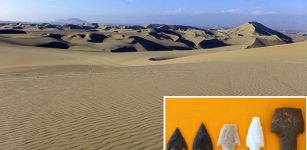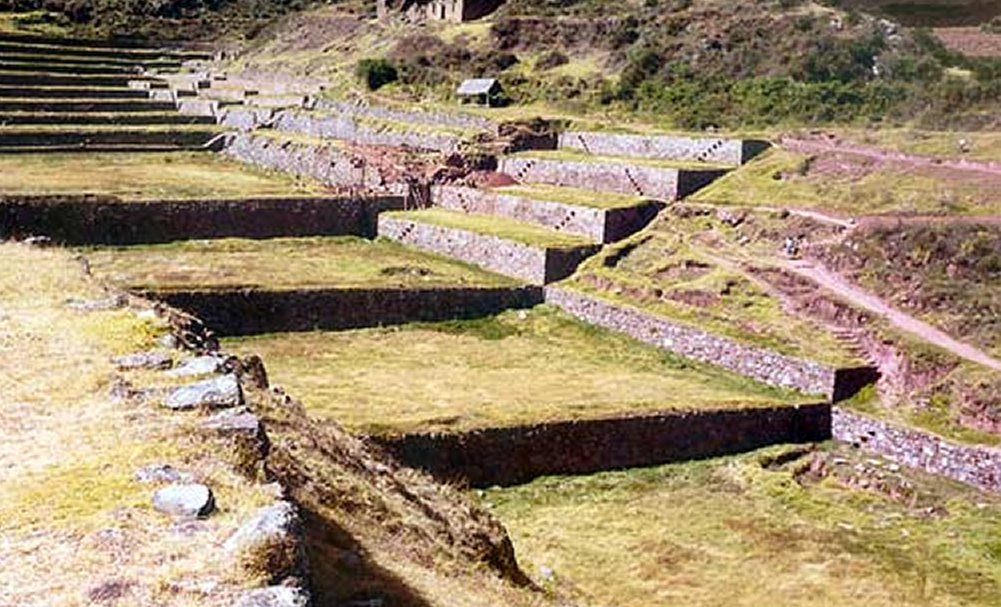Tipón (Tipon): Who Taught The Inca How To Build Artificially Irrigated Garden?
A. Sutherland - AncientPages.com - There are many unanswered questions regarding the Inca’s marvelous engineering masterpiece known as Tipón.
How did the Inca manage to reach this high level of development? What was the source of their advanced knowledge of hydraulics?
Nowhere else in Tawantinsuyu (“Land of the Four Quarters”) as the Inca used to refer to their empire, are there so well-planned and carefully finished agricultural terraces and irrigating channels as in the Tipón complex.
Cusco Tipón terraces. Source
The original name of this Inca site is lost in time; however, Dr. Luis Antonio Pardo, the prominent Peruvian historian, believes that the current name of Tipón may derive from the Quechua word ‘Tuxeuj’ (“to be boiling”). It is believed that Tipón's walled agricultural enclosure was built by earlier people of the Cusco Valley.
As narrated by Inca Garcilaso de la Vega (1539 – 1616), a chronicler and writer, apparently, Tipón was part of the royal estate belonging to Inca Yawar Huaca (Yawar Waqaq), the seventh Sapa Inca of the Kingdom of Cusco (beginning around 1380 AD).
In his book "Tipon: Water Engineering Masterpiece of the Inca Empire", Kenneth R. Wright writes:
“The balance of Tipon is mostly covered by walled terraces for both irrigated and dry land farming. The exceptions are some upper slopes too steep for terraces and a huge, smooth, volcanic rock slab that is so steep that it will not hold topsoil.
Tipon - home to one of the largest irrigation works in terraces, with many outdoor water channels. image source
The massive outer wall of Tipon, 15 to 20 feet high and nearly 4 miles long, encircles the community. The wall provided security and firmly established the perimeter of this estate.
Tipon was a perfect location for the Inca nobility to construct an estate. Its perennial spring, adjacent streams on the east and west, and fertile volcanic soils were coupled with an already walled agricultural enclosure built by earlier people of the Cusco Valley…”
At the same time, Tipon was devoted to religious ceremonies and agricultural experiments. The site that dates back to the beginning of the 15th century, is located at 3,560 meters above sea level, about 23 km southeast of Cusco, in the district of Oropesa (province of Quispicanchis), along the Cusco-Puno road.
It covers 239 hectares and consists of enclosures and wide agricultural terraces irrigated by a network of water channels fed by a natural spring.
Tipón - A Laboratory Of Agricultural Products
Besides being an archaeological complex, Tipón is home to one of the largest irrigation works in the terraces, with a great distribution of outdoor water channels.
This beautiful compound of agricultural terraces, long stairs and stone canals is located 20 km south of the city of Cuzco.
One can think of Tipón as the largest artificially irrigated Inca garden or rather an unusual complex of garden-like structures rising on many levels and on dozens of stone terraces.
This was a garden laboratory, probably used for experimenting with agricultural products, utilizing the various micro-climates found within the complex.
It can be assumed that Tipón was a similar place for Inca agronomists, as Moray (Moroy), famous for its oval farm terraces. Moray, located in the Sacred Valley of the Incas, has an old but very sophisticated irrigation system. Probably like in Moray, also in Tipón, the Incas experimented with the cultivation of new plant varieties of potatoes, corn, and other plants.
To these activities, they needed water that flowed through fine stone structures (aqueducts, spillways, canals and falls) and farm terraces situated at many different levels. Having proper conditions, the Inca plants could grow at different temperatures and with different sun exposure.
 The hydraulic engineering of the Tipon fountain represents a high standard of care to create an aesthetic amenity. Credits: Wright Water Engineer
The hydraulic engineering of the Tipon fountain represents a high standard of care to create an aesthetic amenity. Credits: Wright Water Engineer
Therefore, the terraces rise from the bottom of the valley to its upper edge, while water flows here through aqueducts and canals, freely adjusted.
Centuries ago, the Tipón ingenious complex was most likely destroyed by the Incas themselves, who did not want to leave it in the hands of the Spaniards.
After many years, the complex was reconstructed and restored to its former glory. Tipón was once an important, specially protected place and it is evidenced by a large, oval fort that rises on the northern flank of the complex.
Written by – A. Sutherland - AncientPages.com Senior Staff Writer
Updated on January 20, 2024
Copyright © AncientPages.com All rights reserved. This material may not be published, broadcast, rewritten or redistributed in whole or part without the express written permission of AncientPages.com
Expand for referencesMore From Ancient Pages
-
 Evidence Of Early Metalworking In Arctic Canada – European Technologies Involved
Archaeology | Dec 7, 2014
Evidence Of Early Metalworking In Arctic Canada – European Technologies Involved
Archaeology | Dec 7, 2014 -
 Scientists Solve The Mystery Of Cicero’s Puzzling Words By Analyzing Ancient Roman Coins – Evidence Of Financial Crisis?
Artifacts | Apr 6, 2022
Scientists Solve The Mystery Of Cicero’s Puzzling Words By Analyzing Ancient Roman Coins – Evidence Of Financial Crisis?
Artifacts | Apr 6, 2022 -
 Intriguing Phenomenon Sheds New Light On The Etruscans
Archaeology | Sep 25, 2021
Intriguing Phenomenon Sheds New Light On The Etruscans
Archaeology | Sep 25, 2021 -
 Medieval Irish Book Fitting Among Historical Finds Unearthed In Old Cemetery In Norway
Archaeology | Dec 15, 2017
Medieval Irish Book Fitting Among Historical Finds Unearthed In Old Cemetery In Norway
Archaeology | Dec 15, 2017 -
 Mysterious Rongorongo Script Remains Undeciphered – Does It Contain A Prophetic Warning?
Featured Stories | Mar 24, 2014
Mysterious Rongorongo Script Remains Undeciphered – Does It Contain A Prophetic Warning?
Featured Stories | Mar 24, 2014 -
 Archaeologists Unearthed Alabaster Statue Of Queen Tiye In Luxor, Egypt
Archaeology | Mar 24, 2017
Archaeologists Unearthed Alabaster Statue Of Queen Tiye In Luxor, Egypt
Archaeology | Mar 24, 2017 -
 What Is The Link Between Drought And The ‘Barbarian Conspiracy’ In Roman Britain?
Archaeology | Apr 22, 2025
What Is The Link Between Drought And The ‘Barbarian Conspiracy’ In Roman Britain?
Archaeology | Apr 22, 2025 -
 Unique Ancient Figurine Puzzles Scientists – Was She An Unknown Pre-Historic Water Goddess?
Archaeology | Jul 21, 2022
Unique Ancient Figurine Puzzles Scientists – Was She An Unknown Pre-Historic Water Goddess?
Archaeology | Jul 21, 2022 -
 First Settlers Of Ancient Peru Left Behind 12,000-Year-Old Stone Objects
Archaeology | Mar 16, 2018
First Settlers Of Ancient Peru Left Behind 12,000-Year-Old Stone Objects
Archaeology | Mar 16, 2018 -
 Arrowhead Made Of Meteoritic Iron From The Late Bronze Age Settlement Of Mörigen, Switzerland – Examined
Archaeology | Aug 1, 2023
Arrowhead Made Of Meteoritic Iron From The Late Bronze Age Settlement Of Mörigen, Switzerland – Examined
Archaeology | Aug 1, 2023 -
 Source Of Ancient Roman Silver Was The Iberian Peninsula
Archaeology | Dec 18, 2021
Source Of Ancient Roman Silver Was The Iberian Peninsula
Archaeology | Dec 18, 2021 -
 On This Day In History: Treaty Of Paris Was Ratified – On January 14, 1784
News | Jan 14, 2017
On This Day In History: Treaty Of Paris Was Ratified – On January 14, 1784
News | Jan 14, 2017 -
 Chilling Story Of Glamr Who Became A Draugr, A Living Dead – Scary Yule Haunting
Norse Mythology | Dec 29, 2024
Chilling Story Of Glamr Who Became A Draugr, A Living Dead – Scary Yule Haunting
Norse Mythology | Dec 29, 2024 -
 Secret Hidden Freemasonic Messages Concealed In Ancient Egyptian Artifacts And Roman Works – Curious Stellar Symbol – Part 2
Ancient Mysteries | Feb 23, 2022
Secret Hidden Freemasonic Messages Concealed In Ancient Egyptian Artifacts And Roman Works – Curious Stellar Symbol – Part 2
Ancient Mysteries | Feb 23, 2022 -
 On This Day In History: Captain James Cook Spotted The East Coast Of Australia – On Apr 19, 1770
News | Apr 19, 2016
On This Day In History: Captain James Cook Spotted The East Coast Of Australia – On Apr 19, 1770
News | Apr 19, 2016 -
 4,000-Year-Old Temple With Mysterious Large Monolith Discovered In Cyprus
Archaeology | Jul 10, 2024
4,000-Year-Old Temple With Mysterious Large Monolith Discovered In Cyprus
Archaeology | Jul 10, 2024 -
 On This Day In History: Supernova Observed In The Constellation Cassiopeia Was Recorded – On August 4, 1181
News | Aug 4, 2016
On This Day In History: Supernova Observed In The Constellation Cassiopeia Was Recorded – On August 4, 1181
News | Aug 4, 2016 -
 Look Inside The Amazing Egyptian Tomb Of Scribe Neferhotep In Luxor
Places | Feb 19, 2024
Look Inside The Amazing Egyptian Tomb Of Scribe Neferhotep In Luxor
Places | Feb 19, 2024 -
 Alexander Nevsky: Grand Prince Of Novgorod, Skilled Fighter, Quick–Thinking Strategist Who Defeated Swedish And German Invaders
Featured Stories | Feb 22, 2019
Alexander Nevsky: Grand Prince Of Novgorod, Skilled Fighter, Quick–Thinking Strategist Who Defeated Swedish And German Invaders
Featured Stories | Feb 22, 2019 -
 Mireuksa Pagoda: Largest And One Of The Oldest Of Korean Pagodas
Archaeology | Jan 1, 2016
Mireuksa Pagoda: Largest And One Of The Oldest Of Korean Pagodas
Archaeology | Jan 1, 2016



